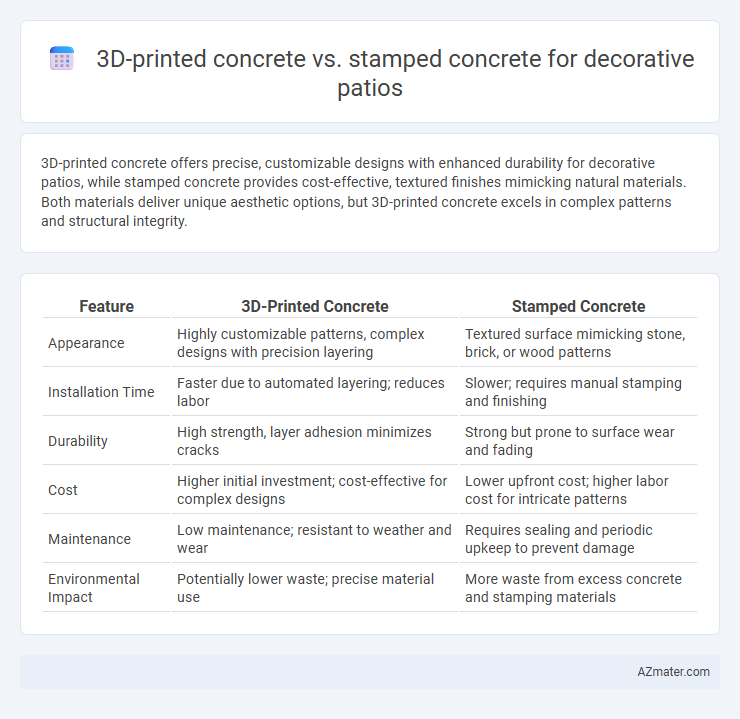3D-printed concrete offers precise, customizable designs with enhanced durability for decorative patios, while stamped concrete provides cost-effective, textured finishes mimicking natural materials. Both materials deliver unique aesthetic options, but 3D-printed concrete excels in complex patterns and structural integrity.
Table of Comparison
| Feature | 3D-Printed Concrete | Stamped Concrete |
|---|---|---|
| Appearance | Highly customizable patterns, complex designs with precision layering | Textured surface mimicking stone, brick, or wood patterns |
| Installation Time | Faster due to automated layering; reduces labor | Slower; requires manual stamping and finishing |
| Durability | High strength, layer adhesion minimizes cracks | Strong but prone to surface wear and fading |
| Cost | Higher initial investment; cost-effective for complex designs | Lower upfront cost; higher labor cost for intricate patterns |
| Maintenance | Low maintenance; resistant to weather and wear | Requires sealing and periodic upkeep to prevent damage |
| Environmental Impact | Potentially lower waste; precise material use | More waste from excess concrete and stamping materials |
Introduction to Decorative Patio Solutions
3D-printed concrete offers precision and customization in decorative patio designs, enabling complex patterns and textures that traditional methods cannot easily achieve. Stamped concrete mimics natural materials with textured and colored patterns, providing an affordable and durable option for enhancing patio aesthetics. Both solutions improve outdoor living spaces, with 3D printing excelling in innovation and stamped concrete in classic versatility.
What is 3D-Printed Concrete?
3D-printed concrete is an innovative construction method that uses computer-controlled printers to extrude layers of concrete, creating highly precise and customizable structures without traditional formwork. This technology enables intricate design possibilities and faster installation compared to stamped concrete, which involves manually pressing patterns into freshly poured concrete. For decorative patios, 3D-printed concrete offers enhanced design flexibility, reduced labor costs, and increased structural integrity.
Understanding Stamped Concrete
Stamped concrete offers a cost-effective and versatile solution for decorative patios, replicating the appearance of natural stone, brick, or slate with textured patterns and color variations. This method involves pouring and imprinting wet concrete with molds or stamps to create detailed designs, allowing for customization while maintaining durability and weather resistance. Compared to 3D-printed concrete, stamped concrete is quicker to install and widely accessible, making it a popular choice for homeowners seeking aesthetic appeal and structural reliability in outdoor spaces.
Design Flexibility: 3D-Printed vs Stamped Concrete
3D-printed concrete offers unparalleled design flexibility for decorative patios, enabling intricate, customizable shapes and patterns impossible with traditional methods. Unlike stamped concrete, which relies on predefined molds and repetitive patterns, 3D printing can produce complex textures and organic forms with precision. This technology allows for innovative patio designs tailored to specific aesthetic and functional requirements, transforming outdoor spaces with unique architectural elements.
Installation Process Comparison
The installation process for 3D-printed concrete involves layer-by-layer automated deposition using specialized printers, enabling precise and customizable design with minimal labor. Stamped concrete requires manual pouring, spreading, and pressing textured molds into wet concrete, which is labor-intensive and time-sensitive to prevent premature curing. While 3D printing reduces human error and speeds up complex shapes, stamped concrete allows for quicker surface finishing and immediate decorative patterns on-site.
Durability and Longevity
3D-printed concrete offers superior durability due to its high-density layering and precise material composition, resulting in enhanced resistance to cracking and environmental wear compared to stamped concrete. Stamped concrete, while aesthetically versatile, tends to be more susceptible to surface wear and fading over time, especially under heavy foot traffic or harsh weather conditions. The longevity of 3D-printed concrete patios often surpasses that of stamped concrete, making it a preferred choice for long-term outdoor decorative applications.
Cost Analysis: Initial and Long-Term
3D-printed concrete offers lower initial labor costs due to automation but requires significant investment in specialized equipment, while stamped concrete has moderate upfront costs with higher labor expenses for detailed imprinting. Long-term maintenance for 3D-printed concrete is minimal because of its uniform structure and reduced cracking, whereas stamped concrete may incur higher repair costs due to surface wear and color fading. Overall, 3D-printed concrete can provide better cost efficiency over time despite higher initial equipment expenses, making it a competitive choice for decorative patios.
Maintenance Requirements
3D-printed concrete for decorative patios requires minimal maintenance due to its precise layering and durability, which reduces cracking and chipping over time. Stamped concrete demands regular sealing to protect the surface from stains, fading, and wear caused by weather and foot traffic. Over time, 3D-printed concrete's low porosity and consistent texture result in fewer repairs, making it a more maintenance-efficient option for long-term outdoor use.
Sustainability and Environmental Impact
3D-printed concrete for decorative patios significantly reduces material waste and energy consumption compared to stamped concrete, as it precisely deposits only the necessary amount of concrete layer by layer. The use of 3D printing technology allows for incorporating eco-friendly additives and recycled aggregates, enhancing the sustainability profile of patios while minimizing carbon emissions typically associated with traditional stamped concrete processes. Stamped concrete, although durable and aesthetically versatile, often requires extensive surface treatments and formwork, resulting in higher resource use and environmental impact throughout its lifecycle.
Which is Best for Your Decorative Patio?
3D-printed concrete offers precise, customizable designs with enhanced durability and reduced labor costs, making it ideal for complex, modern decorative patios. Stamped concrete provides traditional aesthetic appeal with textured patterns that mimic natural stone, wood, or brick, offering a cost-effective and widely available option. Choosing the best depends on your patio design goals, budget, and preference for innovation versus classic decorative styles.

Infographic: 3D-printed concrete vs Stamped concrete for Decorative patio
 azmater.com
azmater.com